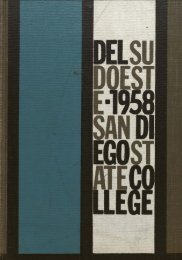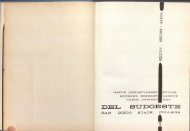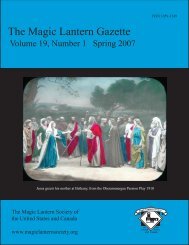The Magic Lantern in Russia - Library
The Magic Lantern in Russia - Library
The Magic Lantern in Russia - Library
Create successful ePaper yourself
Turn your PDF publications into a flip-book with our unique Google optimized e-Paper software.
<strong>The</strong> Editor’s Page 2<br />
<strong>Magic</strong> <strong>Lantern</strong> Reveries <strong>in</strong> <strong>Russia</strong><br />
It is twilight. Reluctantly I rise from my work<strong>in</strong>g-frame. I cannot take any out-door exercise to close the weary day—nor can I for<br />
a moment stir from my chamber. <strong>The</strong> heavy ra<strong>in</strong> falls with <strong>in</strong>creased violence, and the streets stream with mud. I pass the "grey<br />
hour" of twilight <strong>in</strong> pac<strong>in</strong>g the room <strong>in</strong> silent meditation. Ah, my meditations that I revolve <strong>in</strong> my solitude, they br<strong>in</strong>g a whole<br />
world <strong>in</strong>to my soul, call<strong>in</strong>g <strong>in</strong>to my presence, to this my lonely abode, glimmer<strong>in</strong>g with the last fa<strong>in</strong>t light of part<strong>in</strong>g day, so many<br />
dear rem<strong>in</strong>iscences, appear<strong>in</strong>g for a moment, then vanish<strong>in</strong>g like shadows of a magic lantern.<br />
Revelations of Siberia, by a Banished Lady<br />
(London, 1853), vol. 1, p. 274.<br />
Will there be another year like this? Sometimes, as if <strong>in</strong> the magic-lantern, the pictures change; my thoughts wander off to my far<br />
away home, and I beg<strong>in</strong> to converse with my dear ones; these images vanish, and aga<strong>in</strong> my bra<strong>in</strong> is busy with the questions of the<br />
day.<br />
Jonas Stadl<strong>in</strong>g and Will Reason,<br />
In the Land of Tolstoi (New York, 1897), p. 139<br />
This issue of the Gazette conta<strong>in</strong>s two long research articles.<br />
<strong>The</strong> cover article describes the results of some of my own<br />
research on the magic lantern <strong>in</strong> <strong>Russia</strong>, an area long neglected<br />
by magic lantern researchers. My article is by no<br />
means the last word on the subject, because I cannot read<br />
orig<strong>in</strong>al <strong>Russia</strong>n sources, but my hope is that it will be sufficiently<br />
<strong>in</strong>terest<strong>in</strong>g to stimulate other scholars with the necessary<br />
language skills to probe deeper <strong>in</strong>to the subject.<br />
<strong>The</strong> second feature article is a very <strong>in</strong>terest<strong>in</strong>g contribution<br />
by Deac Rossell, a lead<strong>in</strong>g magic lantern scholar, who argues<br />
that much can be learned about the history of the magic lantern<br />
by close study of early illustrations of lanterns. Rather<br />
that just be<strong>in</strong>g decorative or diagrammatic representations of<br />
magic lanterns, these illustrations, accord<strong>in</strong>g to his analysis,<br />
are most likely derived from actual early models of magic<br />
lanterns. Indeed, a t<strong>in</strong>y handful of such lanterns survives to<br />
this day <strong>in</strong> various museums and private collections.<br />
slide and magnify<strong>in</strong>g it on a screen with a system of lenses.<br />
Now digital images are projected by LCD projectors from<br />
computers—no glass slide or color film transparency is<br />
needed. Perhaps this means that <strong>in</strong> the near future, when<br />
someone asks one of us, "What exactly is a magic lantern?",<br />
the usual explanation that it is the ancestor of the modern<br />
slide projector and the movie projector will no longer make<br />
sense to a younger generation. Soon the slide projector will<br />
be as unfamiliar as a rotary-dial telephone is to our children<br />
today.<br />
Kentwood D. Wells, Editor,<br />
451 Middle Turnpike<br />
Storrs, CT 06268<br />
kentwood.wells@uconn.edu<br />
Because of the length of these two articles, a number of other<br />
articles and short pieces sent to me recently have been deferred<br />
until the Summer issue, which I hope to beg<strong>in</strong> soon so<br />
that the publication schedule will catch up to the actual seasons.<br />
Of course, I am always happy to receive additional<br />
material for our journal, either long research articles or short<br />
pieces on magic lantern history or collect<strong>in</strong>g.<br />
This issue appears at an <strong>in</strong>terest<strong>in</strong>g turn<strong>in</strong>g po<strong>in</strong>t <strong>in</strong> the history<br />
of the projected image, with Kodak hav<strong>in</strong>g recently announced<br />
that it will no longer produce Kodachrome film, the<br />
most successful color slide film <strong>in</strong> history. Along with the<br />
demise of the Kodak carousel slide projector a few years ago,<br />
this marks the virtual ext<strong>in</strong>ction of a form of image projection<br />
that has been <strong>in</strong> place s<strong>in</strong>ce the 1600s—the projection of images<br />
from color transparencies by sh<strong>in</strong><strong>in</strong>g a light through the<br />
Load<strong>in</strong>g supplies on a <strong>Russia</strong>n ship, a slide from<br />
the set From the Thames to Siberia. Wells collection

















